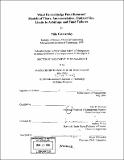What drives hedge fund returns? : models of flows, autocorrelation, optimal size, limits to arbitrage and fund failures
Author(s)
Getmansky, Mila
DownloadFull printable version (6.867Mb)
Other Contributors
Sloan School of Management.
Advisor
John D. Sterman and Andrew W. Lo.
Terms of use
Metadata
Show full item recordAbstract
Hedge funds provide an opportunity for investing with few government regulations and high potential returns. Since 1980 this has lead to the dramatic, 25% annual increase in the number of hedge funds, and with nearly $700 billion managed by hedge funds in 2003. However, high risks associated with hedge fund strategies, competition and limited arbitrage opportunities contributed to an annual attrition rate of 7.10%. In this thesis, models were developed and tested that describe characteristics of fund returns, fund flows, optimal size and the life cycles of hedge funds. The TASS hedge fund database provided by the Tremont Company was used for analysis. In Essay One, it was found that hedge fund returns are highly serially correlated compared to the returns of more traditional investment vehicles such as mutual funds. Several sources of such high serial correlation were explored and the research illustrated that the most likely explanation of this derived from asset illiquidity and smoothing of returns. Illiquid securities are not actively traded and market prices are not always available for them. In the case of smoothing, brokers or managers have the flexibility to report partial returns. Consequently, for portfolios of illiquid or smoothed securities, reported returns will tend to be smoother than true economic returns, thereby understating volatility and increasing risk-adjusted performance measures such as the Sharpe ratio. An econometric model of illiquidity exposure was further proposed and estimators for the smoothing profile as well as a smoothing-adjusted Sharpe ratio were developed. (cont.) ors for the smoothing profile as well as a smoothing-adjusted Sharpe ratio were developed. Estimated smoothing coefficients were found to vary considerably across hedge-fund style categories and may be a useful proxy for quantifying illiquidity exposure. In Essay Two, the life cycles of hedge funds were analyzed. The findings show that in general, investors chasing individual fund performance decrease the probability of an individual hedge fund liquidating. However, when investors pursue a category of hedge funds that has performed well, the probability of hedge funds liquidating within that category increases due to growing competition among hedge funds; and in such environment, marginal funds are more likely to be liquidated than funds that deliver superior risk-adjusted returns. In the Essay, a model was proposed that allows to obtain an optimal asset size by balancing out the effects of past returns, fund flows, market impact, competition and favorable category positioning.
Description
Thesis (Ph. D.)--Massachusetts Institute of Technology, Sloan School of Management, 2004. Vita. Includes bibliographical references (p. 180-182).
Date issued
2004Department
Sloan School of ManagementPublisher
Massachusetts Institute of Technology
Keywords
Sloan School of Management.